A potato flake sourdough starter is a type of fermented sourdough starter that uses potato flakes and sugar to feed the yeast. The starter recipe is gluten- and dairy-free, which means it behaves differently from traditional sourdough or Amish Friendship Bread starters.
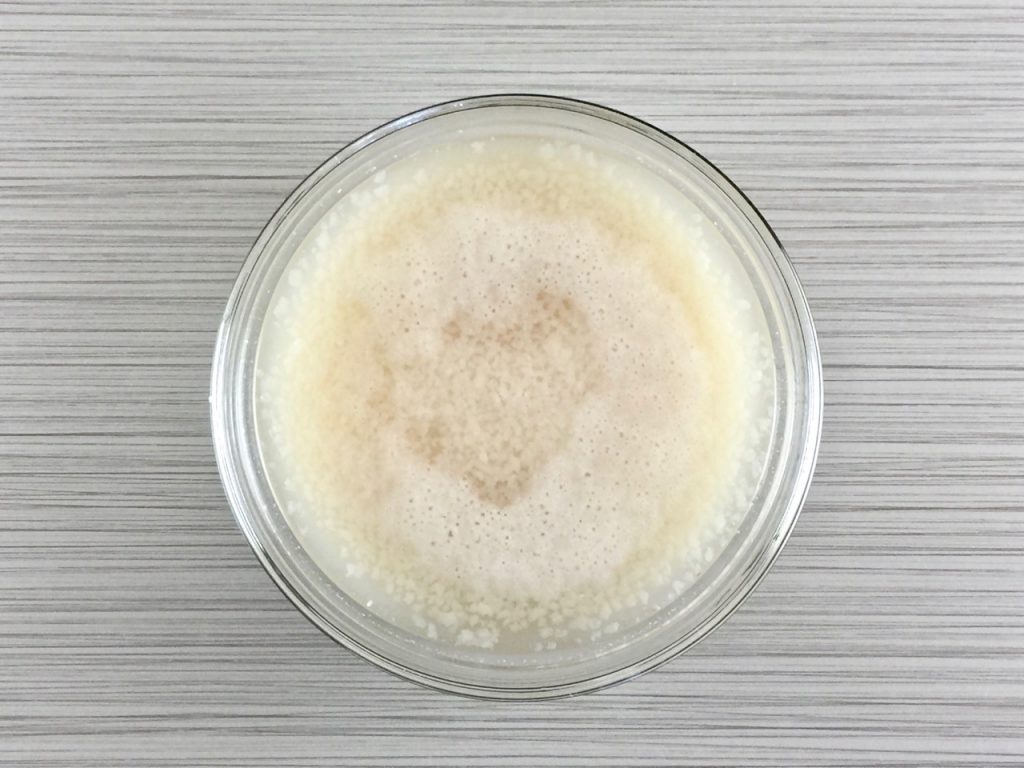
The potato flake starter is used to make loaves of soft, white bread and rolls. There’s also a wonderful cake recipe you can make from the starter. As with all sourdough starters, potato flake starters can be kept indefinitely if properly maintained (read the recipe post for maintenance tips).
Most of the recipes at the Friendship Bread Kitchen use 1 cup of Amish Friendship Bread starter, a flour-based sweet sourdough starter. Because potato flake starters are thinner and more watery than an AFB starter, you can’t use it as a 1-for-1 swap in recipes calling for 1 cup of AFB starter.
But you know me … I say, experiment! Take an AFB recipe and adjust the amount of flour and liquid to accommodate your runnier starter. It’ll take some tweaking, but it can be done, and then you’ll have more options available to you. Plus, the longer you have your starter, the better you’ll understand how it behaves in a recipe. I would reduce any other liquid in your recipe by 1/4 cup, and increase the flour by 1/4 cup, and then adjust from there.
Here are a few distinguishing traits of potato flake sourdough starters:
- ideal for making loaves of sandwich bread or rolls
- sweeter than a traditional sourdough starter
- more thin (runnier) than thick (when compared with traditional sourdough or AFB starters)
- will bubble from activity (but not as much as other starters)
- is stored primarily in the refrigerator rather than at room temperature on the counter
- not easy to “put on hold” if you want to take a short break
- not recommended for freezing (storage)
If you’re not sure about which starter to use, I recommend trying an Amish Friendship Bread starter first. They’re easy to make, more forgiving, and you can make so many different things from your 1 cup of the starter.
The Process in a Nutshell
If you’re going to start the whole process from scratch, here’s how you do it:
Day 1: Make your potato flake starter. Let it ferment at room temperature for two days.
Day 2: Stir.
Day 3: Stir.
Day 4: Feed your starter. Leave on the counter for 8-12 hours or overnight so the yeasts have a chance to eat through some of the food.
Day 5: Move your starter into the refrigerator for 2-3 days.
Day 6: Do nothing (stirring optional)
Day 7: Do nothing (stirring optional)
Day 8: Remove one cup of starter to make the potato flake bread or cake. With the remaining starter, you can either discard, share with friends, or start the process over again by adding 3 tablespoons instant potato flakes, ½ cup sugar, 1 cup warm water to the existing starter (the existing starter should not be more than 2 cups — discard or bake with the excess before feeding). Leave on the counter for 8-12 hours or overnight. You are now back to Day 4.
Like all sourdough starters, there’s some science and art in maintaining your starter and baking with it. Every kitchen is different, and warmer kitchens yield different results from cooler kitchens. It’s also important to you feed your starter at the correct ratios, or the yeasts won’t be able to thrive.
Potato Flake Sourdough Recipes
Here are the potato flake recipes at the Friendship Bread Kitchen:
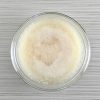

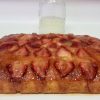
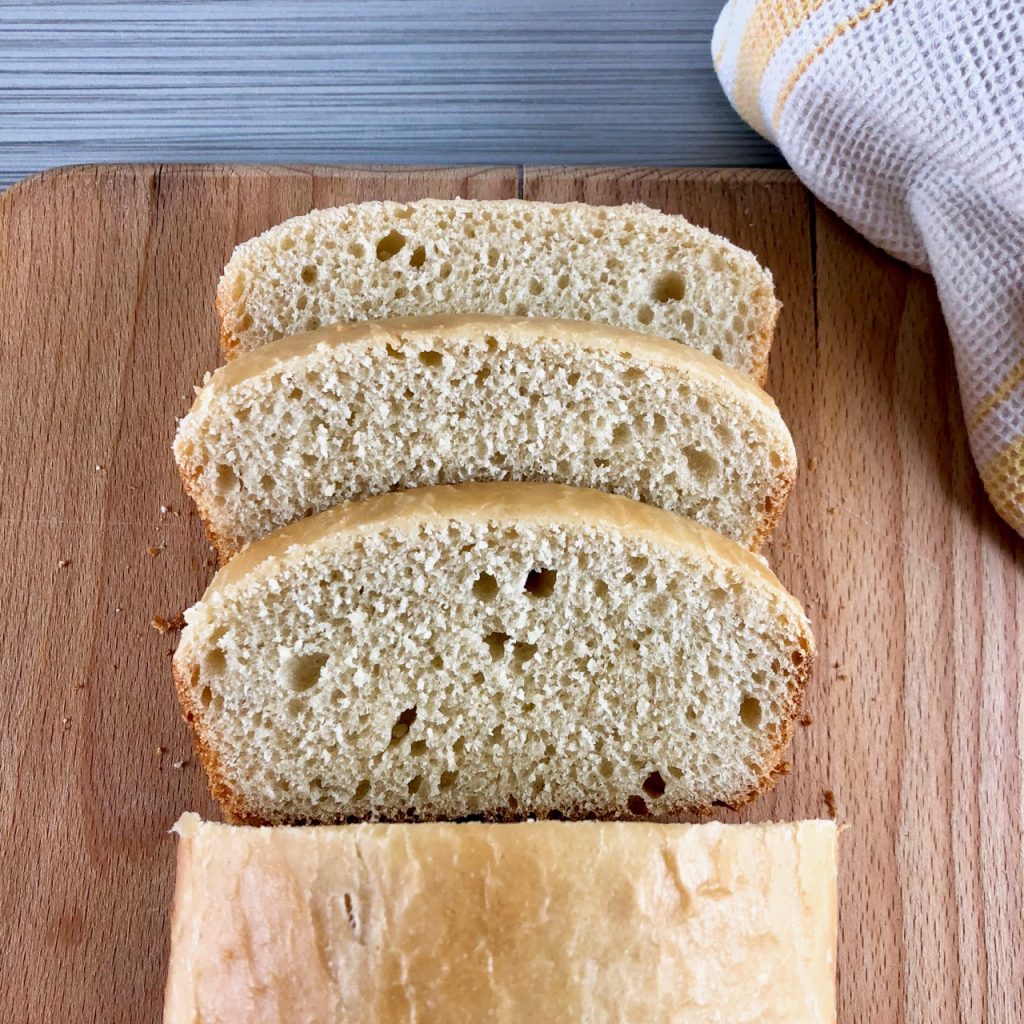
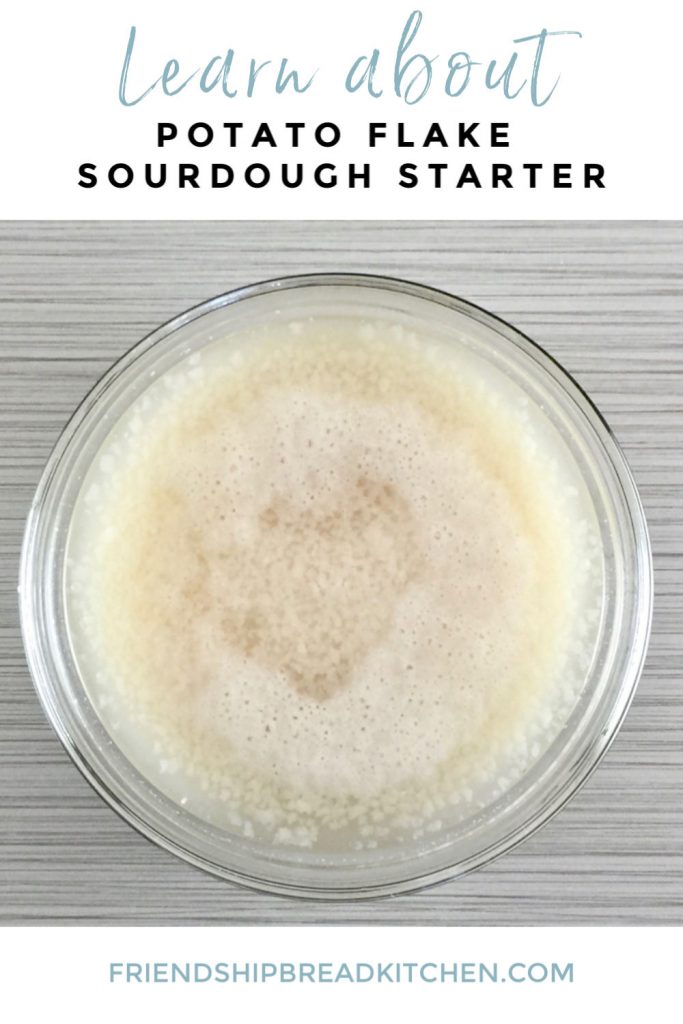
I’m afraid I may have killed my starter by not letting it breathe, it produced a sulfuric smell that is nearly unbearable 🙁 I’m sad about it although I can get more starter from a friend. Can it be revived by “burping it” and then feeding it in around 4 days? It is in the fridge now.
I make bread pretty much every 3 days at this point and have many friends asking for loaves. What is the best way to increase my starter so that I can make larger batches at a time?
I have left my potato flake sour dough stater on my counter all week, due to me winding up in the ER. It looks ok but I am worried about using it. Should I throw it out and start over🤦🏼♀️? Thanks in advance
We have a potato flake sour dough starter. We would like to make some gluten free sour dough bread with it. Can I substitute gluten free flour when making the dough and add to the other ingredients that we normally use?
I got a potato flake starter from a friend and instructions. The bread is good but does not rise much. Her recipe calls for only 2 TBSP Potato flakes instead of 3 along with 1 cup warm water and 1/2 cup of sugar. Then leave on counter for 24 hours and then back in fridge. After 7 days i take out 1 cup of starter to use in bread recipe, then feed the starter, leave on counter for 24 hrs, then back in the fridge. Is the starter suppose be used directly from the fridge or should it sit out to grow before using in the recipe? I am confused. Thanks for any help. Again, the bread is delious, it just doesn’t rise much!
I take it out of the fridge. Feed it and once bubbly then I use it to make bread.
My great aunt gave me the following method. She has been using potato flake starter for nearly 70 years, when she brought it here from Vienna, and her mother before her made the starter from scratch over 100 years ago. This is the schedule that has worked for us:
– Take the starter out of the fridge the night before you plan to feed it (between 8-10 pm;
– In the morning, feed the starter and allow to sit at room temperature until 8-10 pm that night’
– Between 8-10 pm, make your bread according to your recipe and allow it to rise in a covered bowl (or baking pan if making bread that doesn’t require a second rise) overnight;
– At 8-10 AM the next morning, bake your bread according to recipe.
I understand your confusion. I was also confused at first, but eventually it will become a routine, and you won’t even think about it. Enjoy your new journey! You are following a ca. 400-year tradition, and that accounts for something!
If I have left my starter in the fridge for a few weeks, it fizzles when I opened it, can I still use it? How can I revive it?
I would feed and discard a cup then repeat feed. Then discard. Then next feed after bubbly is use it to make bread.
When you say “fizzles,” I am not sure what you mean. Does your starter make fizzling, i.e., popping, sounds? If so, that means your starter is actively eating and is certainly alive. If you mean it is fizzling out, then yes, feed and discard a cup, and repeat few times at room temperature and it should revive. I’ve gone nearly 3 weeks in the fridge without feeding before, and I brought it back to life within a day. These starters are fairly hardy.
I have jars of my own dehydrated potato slices. Can I powder those and use the same measurement of powdered in my starter and feed?
Hello,
I am considering substituting honey for the sugar in both the feeding the starter and making the bread parts of this recipe.
Do you think that would work fine?
I added honey to my original starter for the next feeding and it worked out great!
can you freeze the dough if it is made with a potato flake starter? Thank You
My cousin is an expert at PF Starter and typically the dough does not do well frozen. I am experiementing with freezing the baked bread to see if it thaws and heats well.
My mother used to freeze her loaves of bread and believe me, it was good. She would also keep some on hand to take to cancer patients during their chemo. Most folks told her it was the only thing they could eat with their nausea.
Hi I have a question. After refrigerating the starter can you make the bread Dough with the cold starter or let the starter sit out to room temp first? Thank u!!
You should set the unfed starter straight from the fridge out on the counter the night before you plan to feed it. The next morning, you feed the starter and allow it to remain at room temperature for another 8 hours to become bubbly before making your bread. You make your bread with that bubbly starter. If you do not plan to make any bread that night, remove 1 cup of the fed starter and put the remaining starter back in the refrigerator. Refeed in 5-7 days (basically, repeat the process).
I have only baked with my starter twice so far, but I wish there was more! I accidently only had a half cup left to feed this last time, so I cut the feed in half. Then I fed it again on day two. We eat a lot of bread and I’m trying to figure out how to get enough starter to keep up!
I have used this potato flake starter for years. I have worked my starter up to a batch-and-a-half by saving back 1 1/2 cups of starter instead of 1 cup starter.
When I feed it I add 1 1/2 times the feeding ingredients and when I make the bread, I also use 1 1/2 of the bread making ingredients. That way I get 2 loaves of bread and usually have enough dough leftover to make some cinnamon rolls or dinner rolls. One thing, when i feed 1 1/2 batch of starter, i place my starter in a 1/2 gallon mason jar so it will not overflow as it sets.
Hope this helps.
I’m curious to know if I can add another pack of yeast on the 5th day when I feed it. Would that help it rise more? Thank you.
After creating the starter never add yeast to it at any time. I don’t know the science of it but it loses the taste of sourdough that the starter created. I tried this when I couldn’t get my initial starter to rise properly but I finally got a starter from someone else and it works like a charm now.
My potato flake starter is growing so much. I do discard a cup weekly but that doesn’t make up for what I’m adding. Is there any way or am I able to discard more than one cup weekly?
I always discard ALL EXCEPT 1 CUP OF STARTER, that way I always have the same amount each time I make bread.
Hope this helps.
HI! My name is Molly and I am a student at UNC Chapel Hill taking a fermentation class. For my final project, I am investigating the origin of my grandmother’s sourdough. Her recipe is remarkably similar to yours — potato flakes, sugar, warm water, no milk (like Amish friendship bread) and I have yet to find many other like it! She has been making it since the 60s and lives in Boone, NC. She has no idea where it came from, other than probably NC. I am curious if you know anything about the origin of your starter or recipe. Any hints welcome!
Molly, your comment caught my attention since I have a similar story! First, we live in Durham & are big Tarheel fans. Second, my potato flake sourdough starter originated with my grandmother decades ago in TN, & I’ve often wondered about it’s origin.
My cousin is a teacher at Germanton Elementary in NC (Germanton is in both, Stokes & Rockingham Counties. She inherited a PF starter from a family friend named Linda Lane (now deceased). That starter has been used and shared for more then 40 years. I recently got some and am learning to bake with it.
Check out this story from our local news station https://www.youtube.com/watch?v=vC-LKnV-kMc
I have Herman, a potato flake starter my grandfather raised for over 50 years. A few years before he passed I learned he got Herman from a much older relative who raised him for many years, in New Mexico. Wish I could figure out just how old Herman is!
My family has been using this type of starter for 50 years. This starter works best for us with 3/4c of sugar and 3T potato flakes added to the reserved cup of starter along with 1c of 190°F water after those ingredients and instantly vigorously shaken. I maintain it in a gallon ziploc left a little unzipped inside of the fridge in a cup. After feeding, leave the starter out overnight at room temperature, then you may use it in your recipe. Also you say that it is hard to take a break from the starter, but this method of maintenance makes for a starter that I can neglect for 2-3 months in the fridge and revive without problem. It sometimes just takes an extra discard and feeding while leaving it out for 48 hours.
Any chance you know where it came from?
This is the exact same recipe I use for my starter. I’m having some issues with my bread not being done inside while outside it’s brown and beautiful. Any suggestions?
Scoring the bread helps o release a bit more moisture when baking. I’d give that a try.
Can this bread be scored before baking?
I make this recipe as regular sandwich bread and I do score the loaves.
Can I add potato flakes to an afb made with flour? My starter is getting too big and the flour is expensive!
Been baking for 10 years aft retirement using yeast, conventional SD {both Rye and AP flour based}, Wild Yeast Water {fantastic results but not 100% reliable}.
This Potato Flake starter seemed like it would fit in perfect with my bread baking needs for just 2 people on a 4 or 5 day baking schedule. The starter is very active even when in the fridge.
However, while the 1st bulk rise is fantastic, so much so, I now leave it overnight on the kitchen table instead of my 77F proofing box because I did not like getting up at 4 AM and doing the shaping, panning. Now at approx 68F, at 8.5 hours it has doubled.
Now comes the bad part. No matter how the bulk ferment went, the 2nd rise in the pan/pans was pathetic and not much oven spring. The bread tastes good but it really needs more umph in the 2nd rise.
I have same issue. What am I doing wrong?
I have the same problem on 2nd rise.
I was having the same issue and began adding 1 teaspoon of yeast to the wet ingredients when making my dough and my bread is rising beautifully!!
Is there a recipe for half white/half wheat bread using this starter?
I use this same starter and use half white half whole wheat flour
Yes.i use this recipe and use half whole wheat flour and half bread flour (bread flour works better than all purpose flour) and have been making an incredible loaf of bread.
Hope this helps.
I have been making sourdough for over 25 years, always feeding the starter I was first given. I accidently messed it up and am trying to find a recipe for the starter I used. I was given a starter that obviously had flour, and each time I fed it, I used 1 c. starter, 1 c. flour, 3 Tbsp. potato flakes, and 3/4 c. sugar. Then to make the bread, I added 5 c. flour, 1/3 c. sugar, 1 Tbsp. salt, 1/2 c. veg. oil and 1 1/2 c. water to 1 c. starter and refrigerated the rest for later. I cannot find a starter recipe that resembles the one I had. Does anyone know of one? Thanks for any help.
Hello! I have a starter that I inherited from my mom. It’s about 35 years old! She always called it a friendship bread starter. I feed it every 7-10 days: 1 cup bread flour, 1/2 cup sugar, 1 cup water, and 2 Tablespoons of instant potatoe flakes. To make the bread was your exact recipe. Since I inherited this acouple years ago, I have been searching the internet to see if I could find the origin. The closest I have found is this, however, I myself haven’t tried it, but I think this maybe as close as we get. Let me know if you try it! 😊.
1 Tablespoon of yeast
1 cup of warm water
1/2 cup sugar
3 Tablespoons potatoe flakes
Feed as you normally would every 7-10 days : 1 cup bread flour 1/2 cup sugar, 1 cup water, 2 Tablespoon of instant potato flakes.
I have “dried” out a batch of my starter just in case anything ever happens to it. I don’t know how to rehydrate it, I figure I would cross that bridge if I come to it. I wonder if there is a way I could ship you a dehydrated batch of my starter since it’s so hard to find the origin on the web.
Kathy
I’m curious, I made a starter like this with a flour base and feeding with sugar and potato flakes about 1.5 years ago. I have fed it almost every 2-3 weeks since then and it has performed well. I am wanting to try to make some gluten free bread and am curious about how much flour would still remain in the starter and if bread made with gluten free flour would be essentially gluten free, or if I’d need to start a new starter with a gluten free base. Anyone have any insight? Thanks!
Can this potato flake starter be made using honey or agave instead of sugar
Hi Elaine! We haven’t tried this recipe with agave or honey, so you’ll have to experiment, but we think it should work (in theory) because both of those options do contain sugars.
Noooo Honey will impede the fermentation as it has natural anti bacterial properties.
Curious about this too. What about molasses? Or maple syrup?
Why isn’t this recommended for freezing / storage? I have a potato flake starter that I’ve been feeding regularly, but don’t anticipate making the bread again for quite a while (trying some different things) so was hoping to freeze it. Do you know what happens?
Hi Natalie! We just haven’t found that this starter revives well after being frozen. However, you can always experiment and see what works for you. Let us know how it goes if you try!
Hi! I am an avid potato flake sour dough baker.
My question is this: when I was given my starter,
the recipe sequence says to feed my starter
1 cup warm water, 3/4 cup sugar and 3 T of potato flakes. After setting out on the counter around 12
hours, then pour off 1 cup of the starter and make my bread with that cup, pour off another cup of starter and put back in the refrigerator to feed the next time.
Is this a different recipe from yours?
If I understand your instructions correctly,
you make your bread with 1 cup of starter
BEFORE feeding. Is this correct?
Thank you!
Hi Jane, yes, our recipe is a little different from that. You can look at the directions here: https://www.friendshipbreadkitchen.com/potato-flake-starter-afb/
Hello Jane!
I know that this is over a year old but that sounds like my great aunt’s recipe! Unfortunately she has passed away and I don’t feel like the recipe she mailed me is exactly right when it comes to an amount or step somewhere because mine doesn’t come out tasting like hers. She had typed (or probably had someone type it for her since she was a great aunt) the recipe since so many people asked for it so I’m thinking an amount got changed somewhere when it was transcribed. Could you give me your version to see if it matches hers? I haven’t been able to find a recipe online that matches her amounts. Thank you!
Our family’s starter (40+ yrs. old) works the same as yours… and I discard or use the starter to make bread AFTER feeding it & letting it sit out for 12ish hours.
Hello, I was getting the potato flake starter going but on the third day, when I was supposed to add more flakes, sugar and water, I mistakenly added more yeast also. Much I start over or will this starter be ok?
Hello, I was getting the potato flake starter going but on the third day, when I was supposed to add more flakes, sugar and water, I mistakenly added more yeast also. Much I start over or will this starter be ok?
Hi Joyce! We haven’t had that happen before, but if your starter looks and smells fine, then it should be okay to keep going with it. As a rule of thumb, you never need to add more yeast after you first make your starter. Keep us updated on how it goes!
Hello, a few years ago a friend gave me a jar of potato flake starter which I used for quite a while, then accidentally let “starve” when I didn’t make bread for a few months. I want to make a new jar of starter and this recipe looks similar to what she had. My question is, the photo of the loaf of bread underneath…which of the recipes is that? That’s how my bread used to turn out looking and it was aMAzing, so I want to use that recipe for the bread! 🙂 Thank you!
Here’s the recipe, Karen: https://www.friendshipbreadkitchen.com/potato-flake-amish-friendship-bread/
Happy baking!
I have the Amish Potato Flake starter and is there a way to make the chocolate chip cookies that they usually make from the regular Amish Starter?
Hi Helen! We haven’t tried making chocolate chip cookies with AFB potato flake starter, so you will have to experiment! We would recommend adding a little more flour to the recipe, if your dough seems extra wet with the potato flake starter. Let us know how it goes if you try!
I have a question about the starter. Mine looks much thinner and the liquid and solids are clearly separated. It is active and have a good rise. but the bread comes out with wet sides. I wonder if I should pour out most of the liquid part of the starter before using?
And if I only want to make one loaf, can I simply cut the ingredients to half?
Thank you!
Hi Yinzi! In general, the potato flake starter is thinner and will separate more easily. If you’re still getting a good rise with it, it is probably still active. There are several possible reasons why your bread is coming out wet on the sides. If your oven temperature is too hot, it can sometimes bake too fast on the top, but the insides (or sides) may be undercooked. We wouldn’t recommend pouring out the liquid in your starter. However, if you’re able to use the more solid part of your starter instead of the liquid on the top.
And yes, you can definitely cut the ingredients in half to make one loaf. Let us know if you have any more questions!
An you make bagels?
Hi Crystal! At the moment, for the potato flake starter, we have the potato flake bread recipe or the potato flake strawberry upside down cake recipe
Has anyone made gluten free bread with the potato starter?
We haven’t experimented too much with gluten free bread with the potato flake starter, Kim, but we have heard success stories from some people who have tried. I would recommend experimenting with a 1:1 gluten free flour (maybe this one https://shop.kingarthurbaking.com/items/gluten-free-all-purpose-flour) with the potato flake amish friendship bread recipe here: https://www.friendshipbreadkitchen.com/potato-flake-amish-friendship-bread/
Let us know if you have any more questions!
My brother just gave me a flour based starter. Can this be “converted” to the potato flakes starter?
Hi Rebecca! Because the base of these starters are different, we’d recommend just starting a potato flake starter from scratch. Here’s the recipe, if you’d like to try: https://www.friendshipbreadkitchen.com/potato-flake-starter-afb/ Happy baking!
Do you have anymore recipes for this starter
Hi Linda! At the moment, we only have the bread and rolls recipe and the strawberry upside down cake recipe specifically for the potato flake starter. You are more than welcome to try the potato flake starter in recipes that call for the original Amish Friendship Bread starter, but it usually isn’t a 1:1 ratio so it will take some experimentation. We haven’t swapped this with a potato starter since we mostly use the Amish Friendship Bread starter, but others have said they swap the starters without a problem. You just want to make sure you use an active starter — your starter should be bubbly/foamy and not flat. Happy baking!
Hi Linda,
Years ago, I had the same starter going. I would mix my bread ingredients, let it set awhile, then I’d spread it out slightly, spread on a thin layer of softened butter, then sprinkle with cinnamon sugar. Roll it up and let it rise, then bake. I decided to experiment one day and ended up creating a cinnamon roll bread my kiddos loved.
I was just wondering if anyone had tried freezing the dough(not the starter) and at what stage you would do that(After first/second rise)? and the thawing instructions…
Thank you!
I tried to freeze some rolls prior to cooking and they did not ever rise once thawed. I believe the freeze killed the yeast.
I have had my AFB starter for about 3-4 cycles so it’s fresh and hearty but this cycle is on day 12. Can I continue as usual and make my bread today after feeding it and separating it into one cup measurements. I think it will be fine but I thought I’d ask.
Hi Chanda! Yes, you can definitely bake with your starter after feeding it! Happy baking!
I was given a potato flake starter that had been cared for by a friend. She fed it the day she gave it to me. After leaving it out for the day, I put it in the fridge and didn’t touch it for over a week. I pulled it out today and fed it, but how do I know if it’s still good to use?
When you say “good to use” do you mean safe to consume or still active? Definitely requires feeding every 4-7 days. You would know it is still active by listening to it (my friendship potato starter doesn’t make big bubbles). If in doubt make a half recipe, so as to not be wasteful if it is not very active. Hopefully, it will be edible, even if it is very dense loaf.
Hi Joni! As long as you are properly maintaining it (feeding it on the right days at the correct ratios), and you’re not noticing anything strange (like discoloration or a weird, different smell), it’s most likely fine. You’ll feel more confident after you do a feeding and notice the bubbles. It takes a little time to get to know your starter, but after a couple of weeks, you’ll know how it behaves. Good luck!
Hi,
I need help please. I have been using the potato flake starter. I keep it in the fridge, use it every 5 days or so, Feed it, leave on counter 6-8 hours, refrigerate it and repeat.
However, I noticed when I use my starter (which there is normally only about a cup or so stored) I make bread according to the bread making recipe and I find the bread is dry and very dense. It has a great flavor, but it’s very hard to get the family to eat it because it isn’t pleasant. It is more “brick like” and tends to crumble when I cut it. What am I doing wrong? I would LOVE FEEDBACK as I’m getting ready to scrap the whole idea.
Thanks in advance!
Kris
Hi Kris! The end result should be fluffy, not crumbly and brick-like. So either your starter isn’t ready when you’re making the bread, or one of your ingredients isn’t fresh (just running through the options here), or you need to adapt the recipe and use less flour and more liquid (sometimes when we are kneading the bread, we add more flour to help with the stickiness but you just need to keep kneading), and spend a little more time kneading the dough until it springs back when you press into it. Try that and let me know if that works for you!
I have used potato flake starter for years. It uses flour, potato flakes, sugar and water. I have not had the same result as you. It produces a wonderfully light loaf more like store bread texture, a little heavier, but lovely light tangy flavor. I am in the process of starting it over again, almost have it back to what I want. To me, Friendship or Amish Friendship Bread is a sweet bread, and I wanted something that I could use for sandwiches too. So I adapted it by dropping the amount of sugar that the instructions I had told me to use. It took about 6 months to get a bread that I could use the way I wanted it, and most people like it a lot. It is not thin, and when working gets VERY active and frothy. I am using whole wheat flour now and it is slightly different than the all purpose white flour, but very workable. Not traditional sourdough by any means. LOL.
That sounds wonderful, Anne! The trick to any sourdough/fermented starter is that you have to tweak it for your kitchen and personal taste. Thanks so much for sharing this!
Anne, did you start with the traditional water, yeast, sugar, and potato flake starter? If so, how did you change it and how do you maintain it? Thank you.